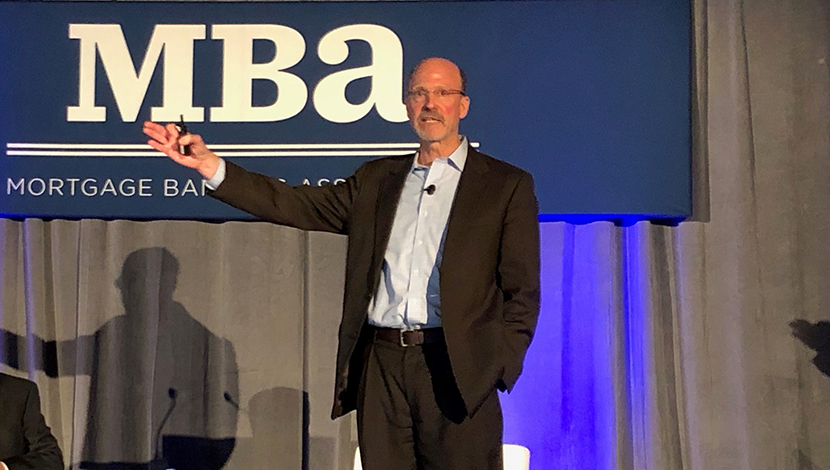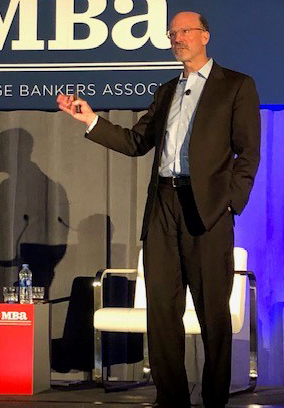
#CREF2020: MBA Says 2020 Commercial/Multifamily Mortgage Maturity Volumes to ‘Return to Normalcy’

SAN DIEGO—The Mortgage Bankers Association said $163.2 billion of the $2.2 trillion (7 percent) of outstanding commercial and multifamily mortgages held by non-bank lenders and investors will mature in 2020, a 48 percent increase from the $110.5 billion that matured in 2019.
MBA released its Commercial Real Estate/Multifamily Survey of Loan Maturity Volumes here at the MBA 2020 Commercial Real Estate Finance/Multifamily Housing Convention & Expo. MBA Vice President of Commercial Real Estate Research Jamie Woodwell said commercial and multifamily mortgage maturities should rise this year from the low levels of the past two years, marking a “return to normalcy.”

“Given the long-term nature of many commercial mortgages, maturities remain muted, with just 7 percent of the total balance of non-bank-held mortgages maturing in 2020,” Woodwell said. “This is particularly true for multifamily mortgages held or guaranteed by Fannie Mae, Freddie Mac and FHA, of which less than 2 percent of the outstanding balance will mature. Loans made by investor-driven lenders, such as mortgage REITs, debt funds and credit companies, tend to be shorter-term, which is why nearly one-quarter of the outstanding balance of those loans will mature in 2020.”
Woodwell noted 2020 “marks the beginning of a ‘return to normalcy’ after the so-called ‘wall of maturities’ in 2016 and 2017, and the ‘trough of maturities’ in 2018 and 2019.” (https://www.mba.org/news-research-and-resources/research-and-economics/commercial/-multifamily-research/blog/blog-posts/current-blog-posts/loan-maturities-over-time).
The report said vacancy rates are pretty stable for most major property types. For asking rent growth, multifamily is ahead of office and retail is lagging.
“Within each property type there are myriad stories,” Woodwell said. “You can break property types down to sub-types. Secondary malls are very different than grocery-anchored centers, for example. If you look at the industrial sector, infill logistics properties are very different than R&D properties. Different submarkets are outperforming in retail while other submarkets are outperforming in multifamily.”
The MBA report noted loan maturities vary significantly by investor group. Only $11.9 billion (2 percent) of the outstanding balance of multifamily and health care mortgages held or guaranteed by Fannie Mae, Freddie Mac, FHA and Ginnie Mae will mature in 2020. Life insurance companies will see $24.8 billion (4 percent) of their outstanding mortgage balances mature, and among loans held in CMBS, $67.2 billion (11 percent) will come due. Among commercial mortgages held by credit companies and other investors, $59.3 billion (24 percent) will mature this year.
“Different property markets are in very different places,” Woodwell said. “The apartment market is like the Energizer Bunny; it was the first property type to come back after the recession and it’s been the leader ever since. There are more multifamily units under construction today than any time since the 1970s, but there is still strong absorption out there. Investors continue to seek out multifamily investment either on the debt or the equity side.”
Woodwell noted the office sector remains volatile. “On one hand, we see strong employment growth; at the same time, we’re seeing people use office space more efficiently, so new demand has not been fully met,” he said. “Offices are in the middle of property types.”
Overall retail growth is 4 percent, “so there is good strong demand,” Woodwell said. “But e-commerce is growing at a 17 percent rate, so an increasing share of retail sales is going thru e-commerce rather than through a retail store. There are some really interesting shifts going on in this sector. There is a move toward ‘experiential’ retail. The type of retail property that has seen the greatest growth is nail salons, because you can’t do that over the internet. So, there are very interesting shifts in the retail sector.”
Woodwell suggested keeping an eye on cap rates. “Cap rates are like SPFs for sunscreen; you need to pay attention to them or you might get burned,” he said. “Cap rates give the purest view into investor investment. Multifamily cap rates have been the lowest for a long time, there are record-low cap rates in this sector as investor demand for multifamily is very strong.”
Woodwell said to think about cap rates as the yield an investor is demanding to invest in a property. “Investors have a lot of alternative things they could invest in,” he said. “Look at 10-year Treasury bonds, which offer a nearly risk-free return. They are paying below 1.6 percent as of Friday. Look at that spread between the risk-free return and what you get investing in a commercial or multifamily property and it’s a little bit wider than usual. Go back a few quarters and it was pretty tight.”
Dollar figures reported are the unpaid principle balances as of December 31. Because most loans pay down principle, the balances at the time of maturity will generally be lower than those reported here.
The MBA survey covers $2.19 trillion of commercial and multifamily mortgages held or insured by life companies, Fannie Mae, Freddie Mac, FHA, CMBS trusts and other non-bank lenders and investors. Banks and thrifts hold an additional $1.4 trillion in mortgages backed by income-producing properties, which are not covered by this survey.
To learn more or to purchase a copy of the report, visit: http://www.mba.org/loanmaturityvolumes.
